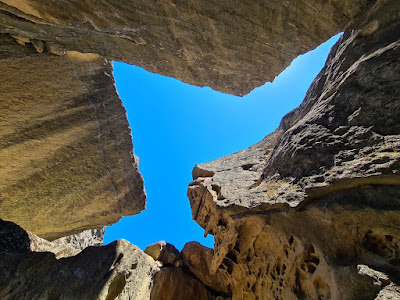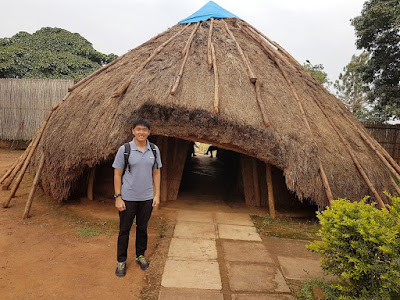AZE: Qobustan Rock Art Cultural Landscape
Qobustan State Historical and Cultural Reserve, Qobustan, Azerbaijan
Daily: 9.00am - 5.00pm

Qobustan is a small municipality that's approximately 65 km from Baku, a perfect destination for a day trip. Located to the west of the settlement is a historical and cultural reserve, part of which features archaeological monuments with captivating rock carvings that have been preserved from the Upper Paleolithic era to the Middle Ages.
---
AZE: Qobustan Rock Art Cultural Landscape <YOU ARE HERE!>
---
This post is the first part of the half-day group tour to Qobustan that my BFF and I booked with TES Tour. We paid US$23.00 (~S$30.50) per person for the guided tour with comfortable shuttle bus. We were picked up from Center City Hotel Baku at around 9.45am.
 |
| The bus is equipped with USB charging ports. |
 |
| The original Bibi-Heybat Mosque was destroyed by the Bolsheviks in 1936, and it was recreated in the 1990s. |
It took around 50 minutes to reach Qobustan from Baku.
 |
| I was somewhat reminded of Uluru, previously known as Ayers Rock, in Australia. |
 |
| There's a museum at the reserve, but the tour doesn't include that. |
The entrance fee per adult foreigner is AZN 10.00 (~S$7.80), which isn't included in the tour price.
After our guide purchased our tickets, it was another 5-minute drive to reach the site of the Qobustan Rock Art Cultural Landscape.
 |
| We were told that those yellow-coloured stones are limestones. |
As expected, there were lots of tourists that morning.
 |
| That's our comfortable shuttle bus. |
The site, which covers an area of 537 hectares, has been inscribed in the UNESCO World Heritage Site list since 2007.
In total, the cultural landscape covers three rocky highlands in the semi-desert territory of central Azerbaijan.
 |
| There's a simple shop that sells tea and snacks near the entrance of the site. |
 |
| That's one of the most scenic public toilets in the country, they say. |

 |
| That's our friendly middle-aged tour guide. |
There are more than 6,000 engravings on more than a thousand rock surfaces, reflecting some 40,000 years of history of rock art.
 |
| Carvings depicting bulls and horses are commonplace. |
The cultural landscape was first discovered by local miners in 1939.
 |
| Does the rock formation look like a face to you? |
 |
| Can you spot a small donkey and a big bull? |
Below is the most obvious carving that we found at the site.
The guided tour lasted for approximately 40 minutes.
 |
| Look at that deer with a nice antler! |
We reached a spot where our guide pointed to a rock and asked us what did we see.
 |
| The moment I saw it, my brain immediately visualised a woman kneeling down. |
Nearby is what was once believed to be a shelter for hunters with mostly hunting scenes being carved on the rocks.
 |
| Images of animals vary as hunting targets shifted from bigger to smaller ones as time progressed. |
 |
| Is that supposed to be a bird? |
Stone No. 92 depicting a one-humped camel was the last carving that we saw that morning.
The level of the Caspian Sea used to be much higher, at least 25.9 m higher than its present state. The horizontal lines on the various rocks tells us the about the level as it receded over the centuries.
 |
| The Caspian Sea was formed about 30 million years ago, around the same time as the Black Sea. |
After our guide was done doing his explanations, we were given about 20 minutes of free time to roam around the site.
 |
| Nobody seemed to be interested to try it out, or perhaps it was out of order. |
As usual, Pikachu and Melon didn't want to miss the opportunity to get their photos taken.
Pardon me for being narcissistic, but I also wanted to get my photos immortalised in the cyberspace.
 |
| We're but a speck of dust in the vast universe, but each and everyone of us is significant in one way or another. |
Enjoy the last few photos of this post without me inside.
 |
| I suppose many people took the chance to find some respite from the UV light as they were enjoying the view. |
Off we went for the second part of the half-day tour: Qobustan Mud Volcanoes!

















































Comments
Post a Comment